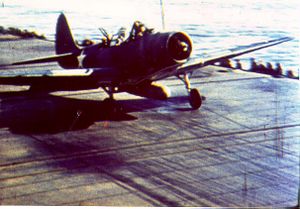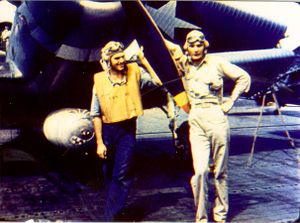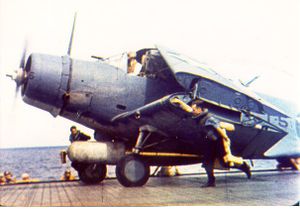PlaneSpottingWorld welcomes all new members! Please gives your ideas at the Terminal.
Douglas TBD Devastator
| TBD Devastator | |
|---|---|
| US Navy TBD-1 Torpedo Squadron Six (VT-6), USS Enterprise (CV-6), 1938. | |
| Type | Torpedo bomber |
| Manufacturer | Douglas Aircraft Company |
| Maiden flight | April 1935 |
| Introduced | 1937 |
| Retired | 1942 (from active service) 1944 (completely) |
| Primary user | United States Navy |
| Produced | 1937–1939 |
| Number built | 129 |
The Douglas TBD Devastator was a torpedo bomber of the United States Navy, ordered in 1934, first flying in 1935 and entering service in 1937. At that point, it was the most advanced aircraft flying for the USN and possibly for any navy in the world. However, the fast pace of aircraft development caught up with it, and by the time of the Japanese attack on Pearl Harbor the TBD was already outdated. It performed well in some early battles, but in the Battle of Midway the Devastators launched against the Japanese fleet were almost totally wiped out. The type was immediately withdrawn from front line service, replaced by the Grumman TBF Avenger.
Contents
Design and development


The TBD Devastator marked a large number of "firsts" for the U.S. Navy. It was the first widely-used carrier-based monoplane as well as the first all-metal aircraft, the first with a totally enclosed cockpit, the first with hydraulically folding wings; it is fair to say that the TBD was revolutionary. A semi-retractable undercarriage was fitted, with the wheels designed to protrude ten inches (250 mm) below the wings to permit a "wheels-up" landing with only minimal damage.
A crew of three was carried beneath a large "greenhouse" canopy almost half the length of the aircrft. The pilot, of course, sat up front; a rear gunner/radio operator took the rearmost seat, while the bombardier occupied the middle seat. During a bombing run, the bombardier lay prone, sliding into position under the pilot to sight through a window in the bottom of the fuselage, using the Norden Bombsight. The offensive armament that he targeted would be either a single Bliss-Leavitt Mark XIII aerial torpedo or a single 1000 lb (450 kg) bomb. Defensive armament consisted of either a .30 or .50 cal (7.62 or 12.7 mm) machine gun firing forwards, and a .30 caliber (7.62 mm) machine gun for the rear gunner.
The powerplant was a Pratt & Whitney R-1830-64 Twin Wasp radial engine of 900 horsepower (671 kW).
A total of 129 of the type were purchased by the U.S. Navy's Bureau of Aeronautics (BuAer), equipping the carriers USS Saratoga, USS Enterprise, USS Lexington, USS Wasp, USS Hornet, USS Yorktown and USS Ranger.
The U.S. Navy became aware by about 1940 that the TBD had become outclassed by the fighters and bombers of other nations and a replacement (the TBF Avenger) was in the works, but it was not in service yet when the United States entered World War II. By then, training attrition had reduced their numbers to just over 100 aircraft. The Devastator had become a death trap for its crews; slow and poorly maneuverable, with light defensive weaponry and poor armor relative to the weapons of the time. Its speed on a glide-bombing approach was a mere 200 miles per hour, making it easy prey for fighters and defensive guns alike. The aerial torpedo could not even be released at speeds above 100 knots [1].
The U.S. Navy assigned popular names to its aircraft in late 1941, and the TBD became the "Devastator".
Operational History
In the early days of the Pacific war, the TBD acquitted itself well during February and March 1942 and in the Battle of the Coral Sea, in which Devastators helped sink the Japanese aircraft carrier Shōhō.
Problems were discovered with the Mark XIII torpedo at this point. Many were seen to hit the target yet fail to explode; there was also a tendency to run deeper than the set depth. It took over a year for the problems to be corrected.
These problems were not fixed by the time of the Battle of Midway on 4 June 1942. Forty-one Devastators were launched from USS Hornet, USS Enterprise and USS Yorktown to attack the Japanese fleet. Their fighter escort lost contact, and the TBDs started their attacks without fighter protection. Torpedo delivery requires a long, straight-line attack run, making the aircraft vulnerable anyway, and the slow speed of the aircraft made them sitting ducks for the Mitsubishi Zeros. Only four TBDs made it back to the Enterprise, none to the Hornet or Yorktown. Worse, not a single torpedo hit its target. However, their sacrifice was not in vain; the suicidally heroic actions of the Devastator aircrews that day drew the Japanese air cover out of position just as the Japanese carriers were refueling and rearming their bombers, a window of opportunity exploited by the late-arriving SBD Dauntless dive-bombers led by Lieutenant Commander C. Wade McClusky.
The Navy immediately withdrew the TBD from front line units after Midway; in any case, there were only 39 aircraft left. They remained in service briefly in the Atlantic and in training squadrons until 1944. The last TBD in the U.S. Navy was used by the Commander of Fleet Air Activities-West Coast. When his TBD was scrapped in November 1944, there were no more[2]. None survived the war.
In fairness to the type, the disaster of the Battle of Midway was as much due to the vulnerability of torpedo bombers against AAA fire and defending fighters. Without a fighter escort to keep off the Zeroes and distract the shipborne AAA guns, not even TBF Avengers escaped nearly as heavy losses.
Operators
- United States Navy[3]
- VT-2 used 58 Devastators between December 1937 and May 1942.
- VT-3 used 71 Devastators between October 1937 and June 1942. They starred in the 1941 movie Dive Bomber.
- VT-4 used 9 Devastators between December 1941 and September 1942.
- VT-5 used 57 Devastators between February 1938 and June 1942.
- VT-6 used 62 Devastators between April 1938 and June 1942.
- VT-7 used 5 Devastators between January 1942 and July 1942.
- VT-8 used 23 Devastators between September 1941 and June 1942.
- VB-4 used 3 Devastators between December 1941 and January 1942.
- VS-42 used 3 Devastators between December 1940 and December 1941.
- VS-71 used 8 Devastators between December 1940 and June 1942.
- VS-72 used 2 Devastators in June 1941.
- VU-3 used a single Devastator from January till May 1940.
- United States Marine Corps
Survivors
There are no Devastators in any collection or museum. Several wrecks are known and are being investigated for possible salvage and restoration:
- TBD-1, BuNo.0298
- Ex-VT-5 / USS Yorktown (CV-5) "5-T-7", Jaluit Lagoon, Marshall Islands.[4]
- TBD-1 BuNo.0353
- Ex-NAS Miami, Atlantic Ocean, Miami, Florida.[5]
- TBD-1 BuNo.1515
- Ex VT-5 / USS Yorktown (CV-5) "5-T-6", Jaluit Lagoon, Marshall Islands.[6]
Specifications (TBD-1 Devastator)
General characteristics
- Crew: Three: Pilot, Torpedo Officer/Navigator, Radioman/Gunner
- Length: 35 ft 0 in (10.67 m)
- Wingspan: 50 ft 0 in (15.24 m)
- Height: 15 ft 1 in (4.60 m)
- Wing area: 422 ft² (39.2 m²)
- Empty weight: 6,182 lb (2,804 kg)
- Loaded weight: 9,862 lb (4,473 kg)
- Max takeoff weight: 10,194 lb (4,623 kg)
- Powerplant: 1× Pratt & Whitney R-1830-64 Twin Wasp radial engine, 900 hp (671 kW)
Performance
- Maximum speed: 206 mph (331 km/h)
- Range: 435 miles (700 km)
- Service ceiling: 19,700 ft (6,000 m)
- Rate of climb: 720 ft/min (3.7 m/s)
- Wing loading: lb/ft² (kg/m²)
- Power/mass: hp/lb (kW/kg)
Armament
- Either
- 1x 0.30 cal (7.62 mm) machine gun forward-firing or
- 1x 0.50 cal (12.7 mm) machine gun forward-firing
- 1x 0.30 cal (7.62 mm) machine gun in rear cockpit (later increased to two)
- Either
- 1x 1,000 lb (453 kg) bomb
- 1x Mark XIII torpedo - 1,200 lb (544 kg)
See also
Comparable aircraft
Related lists
Lists relating to aviation | |
|---|---|
| General | Timeline of aviation · Aircraft · Aircraft manufacturers · Aircraft engines · Aircraft engine manufacturers · Airports · Airlines |
| Military | Air forces · Aircraft weapons · Missiles · Unmanned aerial vehicles (UAVs) · Experimental aircraft |
| Notable incidents and accidents | Military aviation · Airliners · General aviation · Famous aviation-related deaths |
| Records | Flight airspeed record · Flight distance record · Flight altitude record · Flight endurance record · Most produced aircraft |
References
Notes
- ↑ Jackson & Doll 1973, p. 5.
- ↑ Jackson & Doll 1973, p. 43.
- ↑ Tillman 2000, p. 82.
- ↑ TBD Devastator Jaluit Lagoon Survey 2004
- ↑ 1998 Return to the TBD page at the Douglas TBD-1 #0353 wreck website
- ↑ TBD Devastator Jaluit Lagoon Survey 2004
Bibliography
- Adcock, Al. TBD Devastator in Action, Aircraft Number 97. Carrollton, TX: Squadron/Signal Publications Inc., 1989. ISBN 0-89747-231-4.
- Doll, Thomas E. The Douglas TBD Devastator, Aircraft in Profile Number 171. Leatherhead, Surrey, UK: Profile Publications Ltd., 1967. No ISBN.
- Drendel, Lou. U.S. Navy Carrier Bombers of World War II. Carrollton, TX: Squadron/Signal Publications Inc., 1987. ISBN 0-89747-195-4.
- Ginter, Steve. Douglas TBD-1 Devastator, Naval Fighters Number Seventy-one. Simi Valley, California: Ginter Publishing Company, 2006. ISBN 0-942612-71-X.
- Jackson, B.R. and Doll, Thomas E. Douglas TBD-1 "Devastator", Aero Series 23. Fallbrook, CA: Aero Publishers, 1973. ISBN 0-8168-0586-5.
- Kinzey, Bert. U.S. Navy and Marine Aircraft of World War II, Part 1: Dive and Torpedo Bombers. Northbrook, Illinois: Revell-Monogram, LLC, 2003. ISBN 0-99709900-6-7.
- Lawson, Robert and Tillman, Barrett. U.S. Navy Dive and Torpedo Bombers of WWII. St. Paul, MN: MBI Publishing Company, 2001. ISBN 0-7603-0959-0.
- Nowicki, Jacek. Douglas TBD Devastator - SBD Dauntless (Wydawnictwo Militaria 119) (in Polish). Warszawa, Poland: Wydawnictwo Militaria, 2000. ISBN 83-7219-074-7.
- Tillman, Barrett. TBD Devastator Units of the U.S. Navy, Combat Aircraft Vol. 20. Oxford, UK: Osprey Publishing, 2000. ISBN 1-841760-25-0.
External links
Naval Fighters: XFD · F3D · F4D · F5D · XF6D - Fighters: XP-48 · P-70 · F-6 · F-10
Naval Attack: DT · T2D · XT3D · BT · TBD · SBD · XBTD · XTB2D · AD · XA2D · A3D · A4D
Bomber: YB-7 · YB-11 · B-18 · XB-19 · XB-22 · B-23 · B-26 · XB-31 · XB-42 · XB-43 · B-66
Attack: XA-2 · A-20 · A-24 · A-26 · A-1 · A-3 · A-4
Reconnaissance: O-2 · OD · O2D · O-31 · O-35 · YO-44 · YOA-5 · PD · P2D · P3D
Transports: C-1 · C-21 · C-39 · C-47 · C-53 · C-54 · C-58 · UC-67 · C-74 · C-110 · C-118 · C-124 · C-133 · C-24
Naval Transports: RD · R2D · R3D · R4D · R5D · JD · R6D - Experimental: DWC · D-558-1 · D-558-2 · X-3
Lists relating to aviation | |
|---|---|
| General | Timeline of aviation · Aircraft · Aircraft manufacturers · Aircraft engines · Aircraft engine manufacturers · Airports · Airlines |
| Military | Air forces · Aircraft weapons · Missiles · Unmanned aerial vehicles (UAVs) · Experimental aircraft |
| Notable incidents and accidents | Military aviation · Airliners · General aviation · Famous aviation-related deaths |
| Records | Flight airspeed record · Flight distance record · Flight altitude record · Flight endurance record · Most produced aircraft |
cs:Douglas TBD Devastator de:Douglas TBD fr:TBD Devastator it:Douglas TBD Devastator nl:Douglas TBD-1 Devastator ja:TBD (航空機) pl:Douglas TBD Devastator pt:TDB Devastator fi:TBD Devastator vi:TBD Devastator


